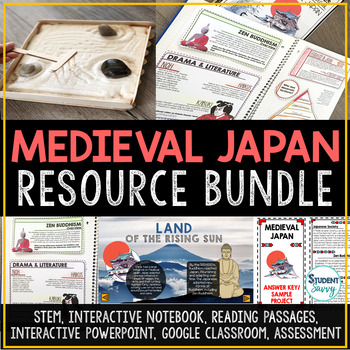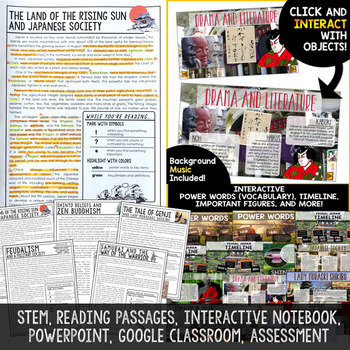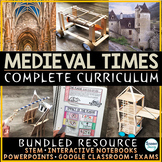Medieval Japan Activities Feudal Japan Projects STEM Reading Passages Writing
- Zip
What educators are saying
Products in this Bundle (6)
showing 1-5 of 6 products
Also included in
- Enhance your Middle Ages curriculum with our Medieval Times and Early Modern Times Complete Curriculum Bundle, available in digital Google Classroom and PDF print formats. With over 1500 pages/slide of material, this comprehensive resource covers Early Byzantine, Early Islam, West Africa, MedievalPrice $190.00Original Price $314.93Save $124.93
Description
Bundle Description
Feudal Japan Activities Resource Bundle!
This bundled product contains the following 6 StudentSavvy resources!
Medieval Japan Interactive Notebook
Medieval Japan Reading Passages
Medieval Japan Interactive PowerPoint
Medieval Japan STEM Challenges
Medieval Japan Google Classroom Student Projects
Medieval Japan Assessments / Exam / Test
_________________________________________________________________
More information on each resource:
-Interactive Notebook
This product contains interactive cut and paste learning material for students to create an organized social studies interactive notebook.
Answer Key Included!
Topics covered in this unit include: Shinto, Kami, Japanese Society, Clans, Hierarchy, Emperors, Regents, Shoguns, Daimyo, Feudalism, Vassals, Zen Buddhism, Noh, Kabuki, Haikus, Lady Murasaki, Tale of Genji, Military Society, Samurai, Bushido, Mongol Invasion, Sakoku, and Much More!
_________________________________________________________________
-Reading Passages
Questions & Answer Keys for Each of the 5 Reading Passages!
COMMON CORE ALIGNED!
Quick overview of topics covered in this resource include:
1.) The Land of the Rising Sun and Japanese Society
-Introduction to Early Japanese Society, structured around powerful families and clans.
-describes the land/islands, farming, and extreme weather
-explains how extreme weather aided the Japanese army when attacked by the Mongols.
-Overview of Japanese society, village workers, nobles, emperors, regents, etc.
-describes how China influenced much of Japan’s religion, government, agriculture, etc.
Keywords: Emperor, Regent, clans, succession, court
2.) Shinto Beliefs and Zen Buddhism
-overviews of Japanese culture and their respect for nature, quiet reflection, spirits, ancestors, and balance.
-overviews of Shinto (the way of the gods) beliefs. Overview of kami (divine spirits)
-describes animism and how it relates to Kami
-Describes Zen Buddhism and how it is an adaptation of traditional Buddhism. Describes how it focuses on quiet reflection, meditation, intuition, and assisted Japanese samurai into battle.
Keywords: kami, Shinto, Zen Buddhism, Zen,
3.) The Tale of Genji and Lady Murasaki Shikibu
-Introduces Lady Murasaki Shikibu – famous writer who lived at the emperor’s court.
-Describes her famous novel, The Tale of Genji
-Overview of plot, setting, etc.
Keywords: court, imperial,
4.) Feudalism and a Military Society
-Introduction to Feudalism (Daimyo having control of the land and weakening the government)
-Describes hierarchy in Medieval Japanese Society
-Describes Minamoto Yoritomo and how he was the first shogun
-Describes three powerful military leaders Oda Nobunaga, Toyotomi Hideyoshi, and Tokugawa Ieyasu
Keywords: shogun, daimyo, vassal,
5.) Samurai and The Way of the Warrior
-Overview of samurai culture in Medieval Japanese society.
-describes bushido, code of honor, and loyalty to their lords
-describes their day-to-day training, jujitsu, wrestling, etc.
-describes how meditation and focus was also important in their practice.
Keywords: bushido, samurai, pledge, Daimyo
________________________________________________________________
-Interactive PowerPoint
This teaching resource is quite the virtual experience! This Medieval Times PowerPoint can be used as a powerful classroom presentation or students can click their way through it on individual computers.
***This product was created with the latest version of PowerPoint (2016). The effects and transitions may not display properly on older versions. Please use the Google Slides version if students are using Chromebooks.
Topics covered in this unit include: Shinto, Kami, Japanese Society, Clans, Hierarchy, Emperors, Regents, Shoguns, Daimyo, Feudalism, Vassals, Zen Buddhism, Noh, Kabuki, Haikus, Lady Murasaki, Tale of Genji, Military Society, Samurai, Bushido, Mongol Invasion, Sakoku, and Much More!
_________________________________________________________________
-STEM Challenges
STEM & STEAM Challenges
Cross-curricular challenges for students who are studying Middle Ages and Medieval Times!
This resource has science, technology, engineering, and measurement activities to do with your upper elementary kids that will really enhance their learning!
There are 2 Medieval Japan STEM Challenges in this pack. Each STEM Challenge has detailed directions, photo examples, a list of materials needed, prediction section, brainstorming section, trials 1, 2, & 3, final results section with drawings, and a reflection section.
The STEM Challenges include:
1. Zen Garden (Zen Buddhism) Challenge
Using a list of supplies, STEM teams must design and build a model of a Zen garden. The garden must contain a constructed sand box, sand , rake, and pebbles or rocks of various sizes and shapes. If students want to add their own features such as branches, moss, or figurines, they may do so. The sand box may only be constructed using Popsicle sticks, glue, and tin foil. STEM teams must also consider what they learned about Zen gardens; their garden should have asymmetrical elements such as the use of odd numbers and various heights in their rock formations. The STEM team with the highest score (see scoring card in resource) will win the challenge! (more instructions and planning pages are given in the resource)
2. Norimono Zipline Challenge
Using a list of supplies, STEM teams must create a Norimono vehicle. There must be a zipline apparatus where the vehicle can travel from one designated point of the classroom to the next by using a pulley that attaches to a string. The Norimono must also have a sliding door mechanism (that can effectively open and close) for the passenger to enter and exit the vehicle.
(more instructions and planning pages are given in the resource)
_________________________________________________________________
-Google Classroom Student Projects
This product contains 3 digital projects that students can complete using Google Slides! This resource has a brochure project, a timeline project, and a info-graphic / poster project.
Each student-centered project has a sample project, answer key, and detailed project instructions for the students.
Info-graphic / Poster Project
Students pick a topic that they would like to research on Medieval Japan (Ex: Zen Buddhism, Drama and Literature, Feudalism, Samurai Training, etc.) All of the elements in the info-graphic must be organized, clearly visible, and well placed. Creativity with color and photos is a must! **More instructions found in the resource
Timeline Project
Using a template, students design a timeline of important events during Medieval Japan. Students can add images, text, and other media to their timelines.
It is up to the teacher to add or change time periods that align with school resources.
Brochure Project
Using a template, students design a brochure that highlights important facts and topics of Medieval Japan such as: Japanese Society, Samurai and Bushido, Zen Buddhism, etc.
_________________________________________________________________
-Exam - Test - Assessment
This resource contains an assessment that has vocabulary matching, fill in the blank, short answer, essay, and an info-graphic. It has 18 questions total.
It also contains an ANSWER KEY and an EDITABLE PowerPoint file.
Tips for Savvy TpT Shoppers:
How to receive credit on TpT to use for future purchases:
• Go to your My Purchases page. Under each purchase you'll see a Provide Feedback button. Simply click it and you will be taken to a page where you can give a quick rating and leave a short comment for the product. I value your feedback greatly as it helps me determine which products are most valuable for your classroom so I can create more for you.
Be the first to know about my new discounts, FREEBIES, and products:
• Look for a green star near the top of any page within my store and click it to become a follower. You will now be able to see FREEBIES and customized emails from my store!
©2019 StudentSavvy
All rights reserved by author. Permission to copy for single classroom use only. Electronic distribution limited to single classroom use only. (unless you purchase the multiple license)






